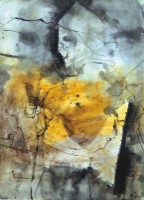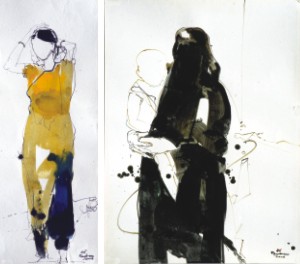| Art
A Grand Symphony
Nader Rahman

When it comes to symphonies we tend to think of Beethoven and Mozart but for two weeks this May we can add another name to that list, Ranjit Das. This may seem like stretching the imagination a bit too far but the fact is that Ranjit Das's current exhibition at Shilpangon defies definition, it mutates music to visual art. The rhythmic movements of his symphony guides one though the mind of an artist in all senses of the word.
The exhibition is suitably titled 'Symphony in Drawing' and from the outset one is impressed with his delicate skills, which merge heavily worked canvases with shadowed images of human figures. The depth in his work remains remarkable. Even though the exhibition is that of drawings rather than classical paintings he manages to manipulate the canvas in such a way that the background and foreground merge into what can only be called a third dimension. It is in his artistic third dimension that the symphony meets the art, that the music ebbs and flows as his colours hold their ground.
 Many early Italian symphonies used an overture 'as the instrumental introduction to a dramatic, choral and occasionally, instrumental composition.' While it could be said that Ranjit's overture was an introduction to an instrumental composition, it would also not be wholly correct. His symphony is not completely instrumental as his art mixes choir and vocal soloists with the overriding instrumental form still taking precedence. To put it simply while some of his drawings sing, others form the music that puts everything in harmony. His overture remains Symphony-4 a beautifully textured work where seemingly ever inch of the canvas has been meticulously worked on. The image is that of a figure playing a drum, turning away from the canvas, looking to the heavens, in a sort of search for spirituality. There is a great deal of vibrancy and a genuine feeling of movement in the piece but it all seems just a little restrained. The figure is not still, nor does it exert an excess of energy. There is a playful toss of the head, swaying to the sound of the drum, the movements are in sync with what it is to be a folk singer in Bangladesh. The immaculately tempered background is ever visible as large swathes of the figure are set into its pattern. A segment of hair, the clothes and even the drum are overrun with background creating a semi-optical illusion of the outline of a figure drenched in its own background. Small wisps of yellow, brown and white add to whimsy of an artist drawing a picture of musician and then naming the exhibition symphony. Many early Italian symphonies used an overture 'as the instrumental introduction to a dramatic, choral and occasionally, instrumental composition.' While it could be said that Ranjit's overture was an introduction to an instrumental composition, it would also not be wholly correct. His symphony is not completely instrumental as his art mixes choir and vocal soloists with the overriding instrumental form still taking precedence. To put it simply while some of his drawings sing, others form the music that puts everything in harmony. His overture remains Symphony-4 a beautifully textured work where seemingly ever inch of the canvas has been meticulously worked on. The image is that of a figure playing a drum, turning away from the canvas, looking to the heavens, in a sort of search for spirituality. There is a great deal of vibrancy and a genuine feeling of movement in the piece but it all seems just a little restrained. The figure is not still, nor does it exert an excess of energy. There is a playful toss of the head, swaying to the sound of the drum, the movements are in sync with what it is to be a folk singer in Bangladesh. The immaculately tempered background is ever visible as large swathes of the figure are set into its pattern. A segment of hair, the clothes and even the drum are overrun with background creating a semi-optical illusion of the outline of a figure drenched in its own background. Small wisps of yellow, brown and white add to whimsy of an artist drawing a picture of musician and then naming the exhibition symphony.

One could be tempted to say that Ranjit's exhibition has a lot in common with Gustav Mahler's epic 8th symphony known as the symphony of a thousand due to the sheer numbers that were needed to perform it; and on its opening night in Munich 3400 people sat in awe as a frail Mahler conducted over a thousand musicians flawlessly. Similarly Ranjit's exhibition could be called that of a thousand shapes, textures and lines which come together in a symphony of drawing.
 Ranjit's exhibits more than the four classical movements which define a symphony, as almost every individual piece is a movement in itself. From stunningly vast yet miserly landscapes to charcoal animals he moves through almost every tempo known to him. While his larger works tend to be more powerful yet restrained in their movement, the smaller more basic charcoals come across as sparse but real. Then again there are exceptions to every rule and his magnificent charcoal drawing of a bull thrusting its front legs is just that. There is an urgency in his lines which seems well placed for such a overpowering piece. The bull does not come across as angry but excited and the dense charcoal holds the attention of ones eyes even though the raging lines tend to draw one back, trying to take in a complete look of a grand piece of art. Ranjit's exhibits more than the four classical movements which define a symphony, as almost every individual piece is a movement in itself. From stunningly vast yet miserly landscapes to charcoal animals he moves through almost every tempo known to him. While his larger works tend to be more powerful yet restrained in their movement, the smaller more basic charcoals come across as sparse but real. Then again there are exceptions to every rule and his magnificent charcoal drawing of a bull thrusting its front legs is just that. There is an urgency in his lines which seems well placed for such a overpowering piece. The bull does not come across as angry but excited and the dense charcoal holds the attention of ones eyes even though the raging lines tend to draw one back, trying to take in a complete look of a grand piece of art.
The other animals in the exhibition are far more passive, yet they generally are more succinct than his larger works. It would be incorrect to say that his smaller animal work is more detailed as one might suspect, but in actually it is simply just sharper. The picture of a hungry skinny dog is one that sticks in the mind as does the piece where a cow is seated with its back facing the viewer. The lines are few and far between and there is a sense of displaced realism that holds the images together.

Aside from animal figures for a musically titled exhibition he also has a fair share of Bangladeshi folk musicians in his work. They sing, move and undulate like Mahler's first movement while thematically and conceptually they share a lot of common ground. The folk/baul musicians Ranjit portrays feel a worldly spiritual connection which could be lined up against Mahler's spirituality which he elaborately dissected in his first movement.
Ranjit also uses the female figure heavily in his work and they hardly ever smile, it seems like his way of depicting the difficulties that define many female lives. There are more than a few drawings where the female shape is in full flow and yet the faces have not been defined at all. Blank white faces on a myriad of slender bodies, they go about their work, they dance, they even sulk and yet their faces have purposefully been deleted, washed out, left blank and anonymous. Why is that so? Why did he choose not to define his female figures, and the answers one gets to that question could be quite different.
 Logically one could say by not giving them a face, he empowers his masculinity and essentially demeans women. If one where to look at the detail, work and size of the bull he drew the anti women sentiment could set in even more. One could claim the sheer size and complexity of the depiction of this male animal when juxtaposed with his slender faceless females is the greatest form of chauvinism. To put it simply it would be silly to view his faceless, expressionless women in that way. By not giving the female figures a face he is portraying how even the greatest women often remain veiled and even worse, not even recognised. It is not his purpose to show sympathy for them, but simply to portray women as society treats them. It is a sign of respect, a silent tribute to all those women who live and work anonymously. This aspect also ties in well with Mahler's second movement of his 8th symphony where he expands on his spirituality with a glowing tribute to women. Logically one could say by not giving them a face, he empowers his masculinity and essentially demeans women. If one where to look at the detail, work and size of the bull he drew the anti women sentiment could set in even more. One could claim the sheer size and complexity of the depiction of this male animal when juxtaposed with his slender faceless females is the greatest form of chauvinism. To put it simply it would be silly to view his faceless, expressionless women in that way. By not giving the female figures a face he is portraying how even the greatest women often remain veiled and even worse, not even recognised. It is not his purpose to show sympathy for them, but simply to portray women as society treats them. It is a sign of respect, a silent tribute to all those women who live and work anonymously. This aspect also ties in well with Mahler's second movement of his 8th symphony where he expands on his spirituality with a glowing tribute to women.
All in all Ranjit's symphony in drawing was exactly what it said it was. Every piece of art was a movement in what could be called his long overdue symphony. Comparisons to Mahler notwithstanding, the body of work is spiritual and personal all in one, and sets the musician at the centre of a symphony of a thousand. The only question that remains unanswered is that of who is orchestrating, a traditional view on the topic would say the artist orchestrates but perhaps a more acceptable notion is that one merely creates the work and then lets it orchestrate its self.
Copyright (R) thedailystar.net 2008 |
